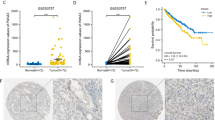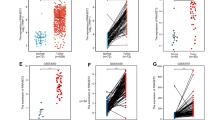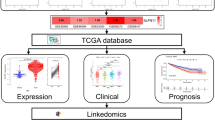Abstract
The effect of Transgelin 2 (TAGLN2) on clear cell renal cell carcinoma (ccRCC) is unknown. This study explored the potential role and mechanism of ccRCC. The expression of TAGLN2 in Pan-cancers was analyzed using the Genotype-Tissue Expression (GTEx) and The Cancer Genome Atlas (TCGA) databases. TCGA-KIRC database was used to analyze subsequent prognostic survival, pathway enrichment, and immune infiltration. Relevant experimental methods could explain the effect of TAGLN2 expression on tumor cell proliferation, migration, invasion, and apoptosis. Apoptosis, proliferation, Epithelial-to-Mesenchymal Transition (EMT), and PI3K/AKT signaling pathway-related protein expression were determined through western blotting. In the TCGA + GTEx database, mRNA-TAGLN2 expression was clearly increased in pan-cancer tissues, and the same result was found in ccRCC patients based on KIRC analysis results. In addition, TAGLN2 was associated with poor clinical stage, pathological grade, and survival prognosis. TAGLN2 is highly expressed in ccRCC tissues and in vitro TAGLN2 silencing of cells inhibits the proliferation, migration, invasion, and EMT of ccRCC cancer cells. Furthermore, TAGLN2-related differential genes enriched in the PI3K/AKT signaling pathway were negatively regulated after TAGLN2 silencing. Moreover, TAGLN2 may promote tumor immune escape and increase the risk of distant metastasis in immune infiltration-related analyses. TAGLN2 can be used as a single indicator to explain the survival probability of patients with ccRCC. In vitro TAGLN2 silencing inhibited the malignant properties of ccRCC by blocking the PI3K/AKT signaling pathway. In addition, TAGLN2 contributes to tumor immune escape and may be a potential therapeutic target for ccRCC.







Similar content being viewed by others
Data Availability
The datasets generated during and/or analyzed during the current study are available from the corresponding author on reasonable request.
References
Capitanio U, Montorsi F (2016) Renal cancer. Lancet 387(10021):894–906
Capitanio U, Bensalah K, Bex A et al (2019) Epidemiology of renal cell carcinoma. Eur Urol 75(1):74–84
Chen J (2011) Multiple signal pathways in obesity-associated cancer. Obes Rev 12(12):1063–1070
Chen P, Zhao X, Wang H et al (2019a) The Down-regulation of lncRNA PCAT18 promotes the progression of gastric cancer via MiR-107/PTEN/PI3K/AKT signaling pathway. OncoTargets Ther 12:11017–11031
Chen H, Zhu D, Zheng Z et al (2019b) CEP55 promotes epithelial–mesenchyl transition in renal cell carcinoma through PI3K/AKT/mTOR pathway. Clin Transl Oncol. https://doi.org/10.1007/s12094-018-02012-8
Ding R, Li G, Yao Y et al (2022) Transgelin-2 interacts with CD44 to regulate Notch1 signaling pathy and participates in colorectal cancer proliferation and migration. J Phrenal Cell Carcinomasiol Biochem 78(1):99–108
Dvorakova M, Nenutil R, Bouchal P (2014) Transgelins, cytoskeletal proteins implicated in different aspects of cancer development. Expert Rev Proteomics 11(2):149–165
Haijian Zhang, Meijuan, et al (2018) miR-145-5p inhibits the proliferation and migration of bladder cancer cells by targeting TAGLN2. Oncol Lett. https://doi.org/10.3892/ol.2018.9436
Han M-Z, Ran Xu, Yang-Yang Xu et al (2017) TAGLN2 is a candidate prognostic biomarker promoting tumorigenesis in human gliomas. J Exp Clin Cancer Res 36(1):155
Hoefflin R, Harlander S, Schfer S et al (2020) HIF-1α and HIF-2α differently regulate tumour development and inflammation of clear cell renal cell carcinoma in mice. Nat Commun 11(1):4111
Jin H, Zheng W, Hou J et al (2021) An essential NRP1-mediated role for Tagln2 in gastric cancer angiogenesis. Front Oncol 11:653246
Jma B, Ajab C, Tt A et al (2022) Inhibition of apelin/APJ axis enhances the potential of dendritic cell-based vaccination to modulate TH1 and TH2 cell-related immune responses in an animal model of metastatic breast cancer. Adv Med Sci 67(1):170–178
Jolly MK, Ware KE, Gilja S et al (2017) EMT and MET: necessary or permissive for metastasis? Mol Oncol 14:317
Li Y, Zhang Z, Zhang X et al (2016) A dual PI3K/AKT/mTOR signaling inhibitor miR-99a suppresses endometrial carcinoma. Am J Transl Res 8(2):719–731
Lin H, Zeng W, Lei Y et al (2021) Tuftelin 1 (TUFT1) promotes the proliferation and migration of renal cell carcinoma via PI3K/AKT signaling pathway. Pathol Oncol Res 27:640936
Liu L, Meng Ti, Zheng X et al (2019) Transgelin 2 promotes paclitaxel resistance, migration, and invasion of breast cancer by directly interacting with PTEN and activating PI3K/Akt/GSK-3β pathway. Mol Cancer Ther 18(12):2457–2468
Liu J, Zhang Y, Li Q et al (2020) Transgelins: cytoskeletal associated proteins implicated in the metastasis of colorectal cancer. Front Cell Dev Biol. https://doi.org/10.3389/fcell.2020.573859
Malarkannan S, Awasthi A, Rajasekaran K et al (2012) IQGAP1: a regulator of intracellular spacetime relativity. J Immunol 188(5):2057
Peng XS, Yang JP, Qiang YY et al (2020) PTPN3 inhibits the growth and metastasis of clear cell renal cell carcinoma via inhibition of PI3K/AKT Signaling. Mol Cancer Res 18(6):molcanres.1142.2019
Popolo A, Pinto A, Daglia M et al (2017) Two likely targets for the anti-cancer effect of indole derivatives from cruciferous vegetables: PI3K/Akt/mTOR signalling pathway and the aryl hydrocarbon receptor. Semin Cancer Biol 46:132–137
Sheng X, Jin J, He Z et al (2020) Pazopanib versus sunitinib in Chinese patients with locally advanced or metastatic renal cell carcinoma: pooled subgroup analysis from the randomized, COMPARZ studies. BMC Cancer 20(1):219
Shi J, Ren M, She X et al (2020) Transgelin-2 contributes to proliferation and progression of hepatocellular carcinoma via regulating annexin A2. Biochem Biophys Res Commun 523(3):632–638
Slomovitz Brian M, Coleman Robert L (2012) The PI3K/AKT/mTOR pathway as a therapeutic target in endometrial cancer. Am Assoc Cancer Res 18(21):5856–64
Suozzi KC, Wu X, Fuchs E (2012) Spectraplakins: master orchestrators of cytoskeletal dynamics. J Cell Biol 197(4):465–475
Wang Lidong, Tan Hao, Huang Yonglian et al (2022) TAGLN2 promotes papillarry thyroid carcinoma invasion via the Rap1/PI3K/AKT axis. Endocr Relat Cancer. https://doi.org/10.1530/ERC-21-0352
Watson M, Vignali PD, Mullett SJ et al (2021) Metabolic support of regulatory T cells by lactic acid. Nature 591(7851):645–651
Xie Y, Chen L, Ma X et al (2017) Prognostic and clinicopathological role of high Ki-67 expression in patients with renal cell carcinoma: a systematic review and meta-analysis. Sci Rep. https://doi.org/10.1038/srep44281
Yang Xia, Zhang QF, Zhen Q et al (2017) Negatively regulation of tumor-infiltrating NK cell in clear cell renal cell carcinoma patients through the exosomal pathway. Oncotarget 8:37783–37795
Ye T, RongrongZhou ChenYu et al (2022) Salvianolic acid A (Sal A) suppresses malignant progression of glioma and enhances temozolomide (TMZ) sensitivity via repressing transgelin-2 (TAGLN2) mediated phosphatidylinositol-3-kinase (PI3K) / protein kinase B (Akt) pathway. Bioengineered 13(5):11646–11655
Yoshino H, Chiyomaru T, Enokida H et al (2011) The tumour-suppressive function of miR-I and miR-I33a targeting TAGLN2 in bladder cancer. Br J Cancer. https://doi.org/10.1016/j.juro.2011.02.1177
Zhang Xiaoyi, Han Jin, Fan Di et al (2022) Lysine-40 succinylation of TAGLN2 induces glioma angiogenesis and tumor growth through regulating TMSB4X. Cancer Gene Ther. https://doi.org/10.1038/s41417-022-00534-6
Zhao Z, Li Lu, Li W et al (2021a) TAGLN2 promotes the proliferation, invasion, migration and epithelial-mesenchymal transition of colorectal cancer cells by activating STAT3 signaling through ANXA2. Oncol Lett 22(4):737
Zhao Z, Lu L, Li W (2021b) TAGLN2 promotes the proliferation, invasion, migration and epithelial-mesenchymal transition of colorectal cancer cells by activating STAT3 signaling through ANXA2. Spandidos Pub. https://doi.org/10.3892/ol.2021.12998
Zhang Y, Ye Y, Shen D et al (2010) Identification of transgelin-2 as a biomarker of colorectal cancer by laser capture microdissection and quantitative proteome analysis. Cancer Sci 101(2):523–529
Zhang S, Wang M, Li Q et al (2017) MiR-101 reduces cell proliferation and invasion and enhances apoptosis in endometrial cancer via regulating PI3K/Akt/mTOR. Cancer Biomark. https://doi.org/10.3233/CBM-170620
Funding
This work was supported by the key research and development projects of Gansu Province (Grant No. 17YF1FA126). Special fund project for doctoral training program of Lanzhou University Second Hospital (Grant No.YJS-BD-25). Cui Ying Science and Technology Innovation plan project of Lanzhou University Second Hospital (Grant No. CY2017-BJ05). Innovative Development Program for Medical Graduate students (Grant No. Izuyxcx-2022-106). Authors Yang He and Bin Zhang have received research support from Panfeng Shang.
Author information
Authors and Affiliations
Contributions
All authors contributed to the study conception and design. Material preparation, data collection, and analysis were performed by [YH], [BZ], and [DH]. The first draft of the manuscript was written by [YD], [XZ], and [HW]. [ZY] designed the concept and experiments. The project was funded by [PS], and all authors commented on the previous versions of the manuscript. All authors read and approved the final manuscript.
Corresponding author
Ethics declarations
Conflict of interest
The authors declare no conflict of interest.
Ethical Approval
This study involving human participants was conducted in accordance with the ethical standards of the institutional and national research committee and the Helsinki Declaration 2013. This study was conducted by the Ethical Committee of the Lanzhou University Second Hospital (2022A-206).
Additional information
Publisher's Note
Springer Nature remains neutral with regard to jurisdictional claims in published maps and institutional affiliations.
Supplementary Information
Below is the link to the electronic supplementary material.
Rights and permissions
Springer Nature or its licensor (e.g. a society or other partner) holds exclusive rights to this article under a publishing agreement with the author(s) or other rightsholder(s); author self-archiving of the accepted manuscript version of this article is solely governed by the terms of such publishing agreement and applicable law.
About this article
Cite this article
He, Y., Zhang, B., Han, D. et al. TAGLN2 Promotes the Proliferation, Migration, Invasion, and EMT of Clear Cell Renal Cell Carcinoma Through the PI3K/Akt Signaling Pathway. Biochem Genet 61, 1265–1281 (2023). https://doi.org/10.1007/s10528-022-10319-z
Received:
Accepted:
Published:
Issue Date:
DOI: https://doi.org/10.1007/s10528-022-10319-z




